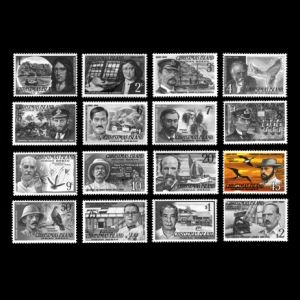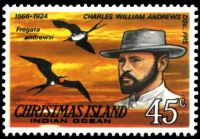the place where Paleontology and Paleoanthropology meets Philately
Christmas Island
Paleontologist Charles William Andrews on stamp of Christmas Island
| << previous country | back to index | next country >> |
Contents:
- Country overview
- Philately of Christmas island
- Official stamps of Christmas island related to Paleontology
- References
Christmas Island, officially the Territory of Christmas Island, is a territory of Australia in the Indian Ocean, comprising the island of the same name. It has a population of 2,072 residents, who live mainly in settlements on the northern tip of the island, including Flying Fish Cove (also known as Kampong), Silver City, Poon Saan, and Drumsite. Around two-thirds of the island's population are Malaysian Chinese, with smaller numbers of ethnic Malays and whites. Several languages are in use, including English, Malay, and various Chinese dialects, while Buddhism is the primary religion, followed by three-quarters of the population. The island was discovered on Christmas Day (25 December) 1643, but only settled in the late 19th century. Its geographic isolation and history of minimal human disturbance has led to a high level of endemism among its flora and fauna, which is of interest to scientists and naturalists. 63% of its 135 square kilometers is an Australian national park. There exist large areas of primary monsoonal forest. Phosphate, deposited originally as guano, has been mined on the island for many years. [R1]
The island issued its own postage stamps from 1958. Those issued by Australia Post since 1993 are also valid in Australia, as are Australian stamps in Christmas Island.
On 1 February 1969, postal responsibility on the island was transmitted by the Phosphate Commission to the Christmas Island Administration. It quickly created a philatelic office and in 1971 chose an agent for sale in the rest of the world, the Crown Agents. The stamp program was then decided locally, produced with the Agents' expertise and printed by specialized printers in Europe, and in Australia starting in the late 1980s. [R2]
So far only one stamp issued by Christmas Island is related to paleontology – a stamp that honors Paleontologist Charles William Andrews. This stamp was issued in 1978 as part of a series on Famous Visitors to the island.
Official stamps of Christmas island related to Paleontology: paleontologist
| 30.04.1977 - 01.09.1978 "Famous visitors" [1] | ||
 |
|
|
Notes:
[1] From April 30, 1977 to September 1, 1978, the Christmas Island Post issued 4 sets of famous visitors to the Island. Each set had 4 stamps that were used as definitives as every stamp has a unique face value from 1 cent to $2.

|
|
British paleontologist Charles William Andrews on stamp of Christmas Island 1978. MiNr.: 80 Scott: 80 |
The 45c stamps (last stamp in the third row), issued on May 31 1978, shows Charles William Andrews (1860 -1924) a British paleontologist whose career as a vertebrate paleontologist, both as a curator and in the field, was spent in the service of the British Museum, Department of Geology. His first concerns were with fossil birds, and he described Aepyornis titan, the extinct "Elephant Bird" of Madagascar (1894). In 1897 he was selected to spend several months at Christmas Island in the Indian Ocean, to inspect it before the activities of phosphate mining compromised its natural history. (Phosphate mining is done to produce phosphate for fertilizers used in agriculture. Nauru is another location where extensive mining of guano deposits was done to ensure the global supply of phosphorous for fertilizers.). The results were published by the British Museum in 1900. [R3]
References:
- [R1] Christmas Island: Wikipedia, WikiTravel, FlagCounter.
- [R2] Postal History and Philately of Christmas Island:
Wikipedia,
Links to official website of the Post Authority, stamp catalog and a list of new stamps of Christmas Island are here. - [R3] Charles William Andrews: Wikipedia
Acknowledgements:
Many thanks to Dr. Peter Voice from Department of Geological and Environmental Sciences, Western Michigan University, for the draft page review and his very valuable comments.
| << previous country | back to index | next country >> |